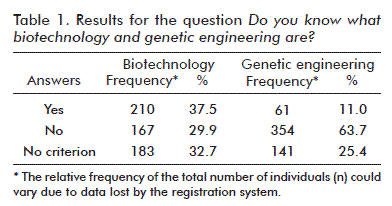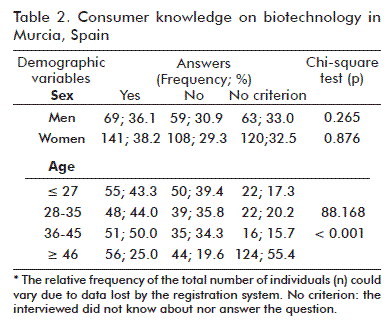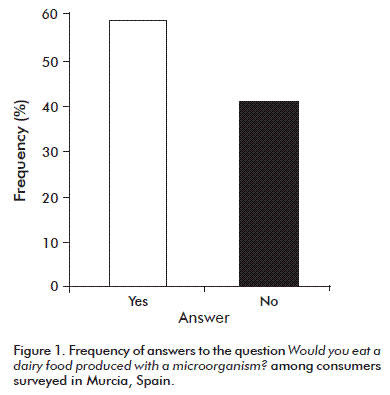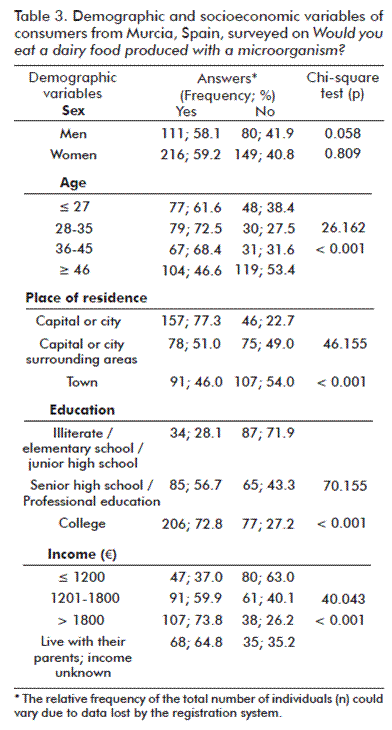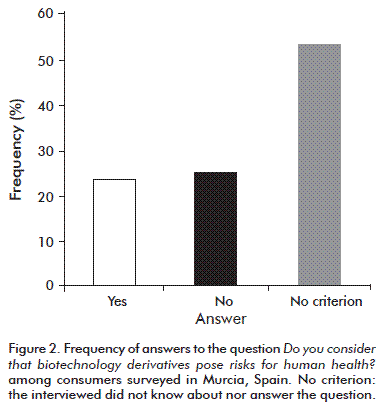My SciELO
Services on Demand
Article
Indicators
-
 Cited by SciELO
Cited by SciELO
Related links
-
 Similars in
SciELO
Similars in
SciELO
Share
Biotecnología Aplicada
On-line version ISSN 1027-2852
Biotecnol Apl vol.32 no.1 La Habana Jan.-Mar. 2015
FOCUS
Knowledge of the consumer from Murcia, Spain, on biotechnology and genetic engineering applied to food
Conocimiento del consumidor de Murcia, España, sobre biotecnología e ingeniería genética aplicadas a los alimentos
Inmaculada Viedma-Viedma1, Serafín Balanza-Galíndo1, José M López Nicolás2, Marta Serrano-Megías3
1 Facultad de Enfermería. Universidad Católica de Murcia. Avenida Jerónimos, 135, 30107 Murcia, España.
2 Departamento de Bioquímica y Biología Molecular. Universidad de Murcia. España.
3 Facultad de Ciencias de la Salud, Universidad Católica de Murcia, España.
ABSTRACT
Human beings always have distrusted from any innovation, especially in topics of food supply. The development of new technologies has contributed to innovation in the food industry. The aim of our study was to know the level of knowledge that the population in Murcia could have on biotechnology and genetic engineering applied to food production and his influence in the acceptance or rejection of these technologies. Results were confronted to other studies in different regions of Spain and Argentine. A quantitative methodology was followed, based on descriptive analyses and bivariable answers, in the Spanish region of Murcia. The results revealed a high level of awareness of the consumer on biotechnology and also a high perception of it as posing a risk for human health. The higher level of unawareness accounted for an increase in the level of distrust against both technologies for food production. This evidenced the need for educational programs able to orient the consumer on the benefits and potential risks of using biotechnology and genetic engineering for food production.
Keywords: biotechnology, genetic engineering, foods, consumer perception.
RESUMEN
Los seres humanos siempre han desconfiado de cualquier novedad, sobre todo en temas de alimentación. El desarrollo de las nuevas tecnologías ha contribuido a la innovación de la industria alimentaria. Se condujo un estudio para conocer el nivel de conocimiento que tenía la población española sobre la biotecnología y la ingeniería genética aplicada a la producción de alimentos, y su influencia en la aceptación o rechazo de dichas tecnologías. Los resultados se confrontaron con los de otras regiones españolas y de Argentina. Se empleó una metodología cuantitativa, basada en el análisis descriptivo y de respuestas bivariables, para el estudio de la población de la región española de Murcia. Los resultados mostraron bajos niveles de conocimiento por parte de los consumidores sobre la biotecnología, así como una elevada percepción de riesgo para la salud debido al consumo de los productos derivados de la biotecnología. A menor conocimiento, mayores fueron los niveles de desconfianza respecto a ambas tecnologías aplicadas para la producción de alimentos. Esto evidenció la necesidad de programas educativos que orienten al consumidor sobre los beneficios y riesgos potenciales que tienen ambas tecnologías para los fines investigados.
Palabras clave: biotecnología, ingeniería genética, alimentos, percepción del consumidor.
INTRODUCTION
Since the origin of mankind, the food for human consumption changed over time as a reflection of their adaptation to the environment and also their interaction with it. The search for new food stocks to be integrated into their diet was a seminal need. Influenced by such remarkable findings such as fire, food stock techniques, food preservatives and others, humans widen and constantly modified their dietary habits [1].
Foods were considered new at the time of their introduction to a given civilization and they are commonly introduced into the diet due to geographic and cultural expansions (for example, the arrival introduction of potato and tomato from American continent into Europe in the 15teen century). Humans have been always resistant to new events in first place and particularly to the introduction of new foods into their diet unless forced by survival, but curiously, this has not forbidden the free exchange of dietary products among different groups and cultures [2].
Noteworthy, during the last 50 years, the most dramatic changes have occurred in the human diet, more than in all the previous ages at once [3]. The societal advances including the economy models and the technical advances made available to consumers for food modification and processing have supported the inclusion of a wide variety of new foods in human diet.
In fact, the food industry has contributed for long to food innovation by introducing new techniques for massive food processing and modification, but this has faced costumer distrust due to unawareness on the potential long term effects, sometimes the lack of adequate information about the newly introduced products, and more recently, the introduction of genetically-engineered foods and their media campaigns.
In this regard, there have been remarkable social debates about the genetic engineering techniques applied to food (commonly known as GM foods), as an example of the confrontation between the scientific-technical advances and the fear to problems that the uncontrolled technological advances could generate in advanced societies. Technological advances commonly reach new frontiers and are put in practice faster than the lag time that follows until its social acceptance or retraction [4]. It cannot be forgotten that the development of applied sciences is conditioned at large by social perception.
Since the development of technological innovations and their social consequences have led to new situations in which the public perception conditions the direction for developments, we questioned which would be the awareness of the consumer on biotechnology and genetic engineering as safe technologies to be applied for food modification.
For this purpose, a survey was conducted by using a quantitative methodology. An observational, descriptive and transversal study was designed among the population of the Spanish region of Murcia, based on a prospective data harvesting from March to November, 2008, in order to support further comparison of the data and results of similar studies previously conducted in other communities in Spain.
Data were statistically processed with basic descriptive tests and a bivariant analysis was done by using the Chi-square parametric test.
CUSTOMER KNOWLEDGE ON BIOTECHNOLOGY
Most consumers perceive food biotechnology as equivalent to genetically modify foods, or paraphrasing, “to put genes into my soup”. This affirmation is devoid of scientific validity, since food biotechnology is nothing more than using a living organism to generate food. In fact, the scientific community defines biotechnology, in general, as the use of a living organism for an industrial purpose [5].
The results obtained in our study revealed that only 29.9 % of the population studied certainly know what biotechnology is (Table 1), with more right answers among young people, and increasing wrong answers with the increase in the age of the population (Table 2). In a previous study conducted in Valencia [6], there was found that only 48 % of young consumers in the 15-25 years age range knew what biotechnology is and 29 % in Murcia. In another study done in Navarra and Madrid regions [7], designed to evaluate how much the consumer knew about biotechnology, the consumers from Navarra believed to know less than those from Madrid, in spite of the very small number of consumers from both populations believing to be certainly aware of biotechnology (3.5 % and 13.3 %, respectively). Altogether, these results led us to believe that the population in Spain is highly unaware of biotechnology and its implications; despite it is an ancient technology.
Asking consumers Would you eat a dairy food produced with a microorganism? was aimed to confirm if the consumer could identify that this is one of the food biotechnology applications and to corroborate their knowledge on that matter. Surprisingly, 41.1 % of the consumers answered No (Figure 1), evidencing that most of them do not know what they daily do and that dietary habits are not perceived as biotechnology-related. By the contrary, there were 6.9 % of consumers that either would eat dairy products or actually know that these are produced by using microorganisms, but their perception was unrelated to any biotechnological process.
The consumers with the lowest knowledge on biotechnology in the Murcia region were older than 46, from rural communities, and of low education and incomes (Table 3). The fact that 27.2 % of consumers with college education asserted that they would not eat a dairy food produced with a microorganism puts a warning on the scientific level of the educational system in Spain, since it would indicate the need for introducing contents in college programs on the technologies that reach the consumer, beyond the general information provided through media.
In a study among young consumers in Valencia [6], 61 % answered No to the same question, declining to eat this type of product and evidencing a higher unawareness than the population in Murcia. For a purpose equivalent to ours, in the Eurobarometer 2005 survey [8], a yes-or-no question was proposed as assertion to customers on: The yeasts used to produce beer or wines are living organisms. And 35 % of the European population in that study considered that assertion false, reflecting the general unawareness on food biotechnology issues.
In a human society as that planned for the XXI century, focused on the survival of the human species and pursuing the utmost possible living conditions, health is the central concern among the population. Therefore, it is plausible that any fact perceived as detrimental for health will be rejected, and that perceived as beneficial accepted. Asking the consumer on Do you consider that biotechnology derivatives pose risks for human health? revealed that 23.4 % of consumers believed they do and 52.8 % did not (Figure 2). This let us to think that in the region of Murcia there were many doubts and skepticism about biotechnology, probably due to the unawareness on the matter. The same question was formulated in Argentine in 2003 [9], and only 20 % of the surveyed population considered that there were no risks for health, for a perception lower than in our study, also considering that our study was conducted five years later. Such level of distrust of the consumer on biotechnology-made foods could lead to their rejection in advance, unless a proper education could be provided on the factual risks that these foods could really have for human health.
With the aim to know the prejudices of the consumers on the risks of biotechnology foods for human health, those people who considered that they posed risks were further asked to declare which would be such risks to their consideration. A number of possibilities were provided: allergies, health conditions, malformations, genetic mutations and chronic diseases. A high percentage of consumers, 38.6 %, believed that these foods posed risks but they could not specify their nature. Allergies were the most claimed risk (36.3 %). Curiously, in the previously mentioned study made in Argentine in 2003 [9], allergies also received the highest score. Possibly, there has been a more significant awareness during the last years among the population on the increase in allergies onset, which could be perceived as related to biotechnology based on their misassumption.
CUSTOMER KNOWLEDGE ON GENETIC ENGINEERING
The customers of Murcia were asked about What do you understand for Genetic Engineering? And, surprisingly, a high percentage of the population surveyed (63.7 %) knew what genetic engineering is, in spite of being this technology newer than biotechnology (Table 1). Noteworthy, 20.5 % of the population confounds biotechnology with genetic engineering, what further complicates the picture. Once again, elder people of lower education levels and of low incomes show the lowest knowledge on this matter (Table 4).
ATTITUDE OF THE CONSUMER TOWARDS GENETIC ENGINEERING AND ITS IMPLICATIONS
The European society is not insecure to scientific developments, been characterized by trust and optimistic attitudes, instead of coexisting with ambivalent positions against certain technological advances such as the uncontrolled use of nuclear science and genetic engineering [10].
According to an opinion poll conducted by the Spanish Foundation for Science and Technology in 2004 [11], the general population adopts a slightly positive attitude to science and technology. In that study, Murcia was among the leading Spanish autonomous regions and Madrid in the second group, this last above the mean for the country. Navarra and Valencia communities were below the country mean.
There has been evidenced that consumers perceive differently the use of genetic engineering on foods depending on the given use [12]. The introduction of the “quality” certification in the last years has proven to generate a safety perception in consumers, providing them with a feeling of safety, improvement, wellbeing and so on. If the action itself improves quality, the given method is perceived as instrumental, not determinant for the acceptance of the result. In line with this, when consumers were asked if they would agree on using genetic engineering for purposes such as: to increase food production, improve food organoleptic properties or quality, or to generate oral vaccines, 67 % of them agreed if the final purpose would be the increase in food quality (Figure 3). The other options received fewer assertions, although the number of consumers accepting the use genetic engineering for foods was greater for each of them. This last indicates a positive attitude in the region of Murcia on food production.
Most concerns on the use of genetic engineering were conditioned by the type of microorganism modified or treated with this technology. In fact, consumers favored the use of genetic engineering in foods and plants, in detriment of animals and humans when questioned about Do you agree with the use of genetic engineering in plants, fermented foods, animals or humans? (Figure 4). In the abovementioned survey in Argentine [9], plants were also favored to animals. Precisely, the insecurity derived from the unawareness causes the rejection of the consumer to use genetic engineering in animals and principally in humans. It is intriguing if the perception would be turned if asking the consumers on the use of genetic engineering techniques to improve human health. Such an inquiry requires further studies.
CONCLUSIONS
A high level of unawareness was found among the population in Spain on biotechnology and its application in foods, in spite of younger consumers showed greater knowledge on this matter. It was surprising the high number of consumers with college degrees that were unaware of food biotechnology applications. The high degree of unawareness drives the consumer to reject foods obtained by biotechnological or genetic engineering procedures, caused by perceptions about them as posing risks for human health.
The human behavior of acceptance or rejection of the new is highly influenced by the background knowledge of the matter in question. The lack of proper information on the impact and relevance of biotechnology and genetic engineering for the human diet among the population generates rejection from consumers, regardless their dietary needs.
This evidences an increasing need for a general call to all the society factors involved (educational institutions, scientific communities and media, among others) to provide the consumers with adequate and complete information on the actual benefits and risks that biotechnology and genetic engineering-generated foods could represent for human health.
REFERENCES
1. De Castro T. Fuentes olvidadas para la historia de la alimentación bajomedieval: crónicas, libros de viaje y biografías. Arqueología Medieval. 1996;6:247-53.
2. López Nicolás JM, Aguirre Balsalobre I. Los nuevos alimentos. In: López Nicolás JM. Nuevos alimentos para el siglo XXI. Murcia: Universidad Católica San Antonio; 2004. p. 15-49.
3. Martínez Álvarez, JM. La evolución de los hábitos alimentarios en España: las nuevas tendencias, los nuevos alimentos y su relación con la salud. In: Nuevos alimentos para nuevas necesidades. Madrid: Instituto de Salud Pública; 2003. p. 7-33.
4. Cámara M. Percepción social de los organismos modificados genéticamente. In: Muñoz E. Organismos modificados genéticamente. Madrid: Ephemera; 2006. p. 157-73.
5. Ramón D. Nuevas aplicaciones de la genética en la alimentación: los alimentos transgénicos. Alimentación, Nutrición y Salud. 2004;11(1):1-5.
6. Calvo MD, Ramón D, Peris J. La opinión de los jóvenes valencianos sobre los alimentos transgénicos. Los transgénicos ciencia y polémica. Málaga: HEFAME; 2000.
7. Sánchez M, Barrena R. Comportamiento del consumidor navarro frente a los alimentos de nueva generación: alimentos transgénicos y alimentos funcionales. V congreso de economía de Navarra. 2003.
8. Gaskell G, Stares S, Allansdottir A, Allum N, Corchero C, Fischler C, et al. Europeans and Biotechnology in 2005: Patterns and Trends. Final Report on Eurobarometer 64.3. A report to the European Commission’s Directorate General for Research; 2006.
9. Sarquis A, Alais F. Consultas sobre la biotecnología en la Argentina. Proyecto SAGPYA UNEP-GEP para la elaboración del marco nacional de bioseguridad. 2003 [cited 2009 Apr 16]. Available from: http://www.agrodigital.com/ante/32/SAGPYA.pdf
10. Osseweijer P. Campañas institucionales sobre biotecnologías en Europa. Quark. 2004;33(julio-septiembre):39-49.
11. Fundación Española para la Ciencia y la Tecnología. Alimentos funcionales. Madrid: FECYT; 2005.
12. Hollman WK. Public perceptions of biotechnology: another look. Nature Biotechnol. 1996;14:35-8.
Received in January, 2015.
Accepted in April, 2015.
Inmaculada Viedma-Viedma. Facultad de Enfermería. Universidad Católica de Murcia. Avenida Jerónimos, 135, 30107 Murcia, España. E-mail: iviedma@ucam.edu













